#rochester family photographer
Explore tagged Tumblr posts
Text
At Robin Fox Photography, we offer professional event and corporate photography services, establishing ourselves as the best photographer in Rochester New York. Whether it’s a corporate gathering, gala, or community event, our experienced team captures the atmosphere and emotions of the occasion. We understand the importance of representing your brand and its values through photography, and we strive to deliver images that reflect the spirit of your event.
Robin Fox Photography 250 North Goodman Street #414, Rochester, NY 14607 (585) 330–5984
Official Website: https://robinfoxphotography.com/ Google Plus Listing: https://www.google.com/maps?cid=17778382636070770175
Other Links best wedding photographers rochester new york : https://robinfoxphotography.com/wedding-photographer/ family photographers rochester ny : https://robinfoxphotography.com/family-photographers/ engagement photographers rochester ny : https://robinfoxphotography.com/engagement-photographers/
Other Service We Provide:
Photography wedding photography engagement photography family photography
Follow Us On
Twitter: https://twitter.com/RobinFoxPhotog1 Pinterest: https://www.pinterest.com/robinfoxphotography/ Facebook: https://www.facebook.com/Robinfoxphotography Instagram: https://www.instagram.com/robinfoxphotography/
#engagement photographers rochester ny#family photographers rochester ny#rochester new york wedding photographer#top photographer rochester new york
0 notes
Text

Events Photography
Danny Armor Photography Studio is a leading photo studio that specialises in headshots, portraits, event photography and more. Our photographer has a keen eye for detail and clicks candid photos that reflect your unique personality. Whether you need maternity photography, family photography or party photography, we offer all. Call now!
visit here:-https://dannyamorphotography.com/
#photographer rochester#photography rochester#photography studio near me#kent photography studio#personal photographer#family portrait photography#portrait photography studio
1 note
·
View note
Text

Polyphemus Moth (Antheraea polyphemus), male, family Saturniidae, Rochester, MN, USA
photograph by Glenda Mueller
338 notes
·
View notes
Text










Photographer: https://anastasiasphoto.com
#chic#style#ootd#wedding#bride#bridal#sailormoon#sailor moon#Princess#princess serenity#tuxedo mask#moon#full moon#blerdlife#bleed#black woman#black beauty
2 notes
·
View notes
Text
Wouldn't You Like to Know, ch. 10

Ten
Marina was engaged. Engaged to the asshole that she’d cheated on him with. The whole thing made Colin sick to his stomach. That was the real reason he didn’t want to tell the press those pictures with Penelope weren’t real. He couldn’t film a movie and do a press tour with everyone asking about the photographer he had punched because of the lewd things they’d said about her. They had been together since they were teenagers, and had done two movies together. For a while, they’d been something of a popculture moment where everyone had wanted to know about them.
The attention had gotten too much for Marina.
And she’d been in love with someone else the whole time. Something, he remembered, Whistledown Blast had said since the beginning. He’d been ignorant and because they’d outed Daphne and Simon’s relationship before she was about to marry the prince, he hadn’t been willing to listen. But now, Colin realized that the Whistledown Blast had been Penelope.
And all Penelope had been doing had been helping people see the truth. They might not have liked it, but there was nothing the gossip account had said that hadn’t been true. Penelope had simply said things other people didn’t like to hear. Colin’s only problem was that she didn’t take credit for herself. He knew exactly why that was. Her domineering, overbearing mother. Which was why, after the news was released about Marina and Penelope, he decided to pay a visit to Portia Featherington.
It wasn’t that hard, really. Portia lived in the penthouse above theirs, something she had always been immensely proud of. To the point it had caused some conflict between her and his mother in the past. Portia was from old money, but when her husband had stolen from the Bridgerton’s, they had nearly lost everything.
Portia had eventually rebuilt the family fortune with a fashion line. But it was nowhere near as grand as it once had been. Still, she held onto the Featherington penthouse on the Upper East Side for dear life.
Colin had gotten up early, grabbed coffee, then found himself at Portia Featherington’s penthouse. He knocked on the door. He was surprised when Penelope’s tall, long necked sister, Prudence Featherington, answered the door.
“Oh! Colin!” she looked him up and down, scowling. “What are you doing here? I thought the Bridgerton’s vowed never to come here again. Or at least, your mother did.”
He smirked. “I am here to put an end to that.”
“An end to a family feud that has been going on for decades? Even when my father was in business with your mother?”
Colin nodded. “Is your mother home? I brought her coffee. Black, exactly how she likes it.”
“She’s in her study.”
Prudence didn’t move. “You know, I was there, that day when you said what you said about asking Pen out because your mother made you. And I saw the pictures of you sneaking out from her apartment online. She took forever to be independent because of everyone turning against her, and she just started seeing someone recently. Don’t mess this up for her. I don’t want to see her in a dark place again like she was.”
He tilted his head to the side. “What do you mean, Penelope’s seeing someone?”
“She started seeing that guy she was friends with in high school that she never went out with because she was always too hung up on you. David Debling.”
Colin clenched his jaw. He remembered David Debling. He had been the editor of the school newspaper, and had always been a little too pretentious for his own good. He’d never liked Colin, and Colin had never figured out why. “I didn’t know that. I only reconnected with Pen recently because of work. She’s Lulu Rochester’s assistant. I’m adapting her book into a movie.”
“Don’t mess this up for her,” said Prudence, “she’s been alone long enough----punishing herself for whatever insult your family thinks that we did to you. She deserves to be happy.”
“What are you talking about?” Colin said. “I never stopped talking to Pen. She stopped talking to me.”
“Eloise told her to stay away from you all, like she was some kind of criminal. I know Penelope and I don’t always get on, but she’s still my sister, and I don’t like seeing her hurt. After Eloise stopped being her friend, she got really sad and really lonely there for a long time. It’s only been in the past few years she’s been able to get some confidence back. I don’t want you ruining that for her.”
Colin clenched the cup of coffee he’d originally bought for Portia. Maybe Eloise was right. Getting involved with Penelope was a bad idea. But hadn’t his mother always told him that the Featherington’s lived for drama? “Actually, forget it. I made a mistake.”
Prudence smiled triumphantly. “Good.”
He shook his head and left. Before he did anything, he was going to have to talk with Penelope. The Featherington’s thrived on drama. He had no way of knowing if this was only Prudence’s way of trying to start something. But he needed to sort things out with Penelope first, before he went through the trouble of trying to keep Portia from starting her own.
2 notes
·
View notes
Photo
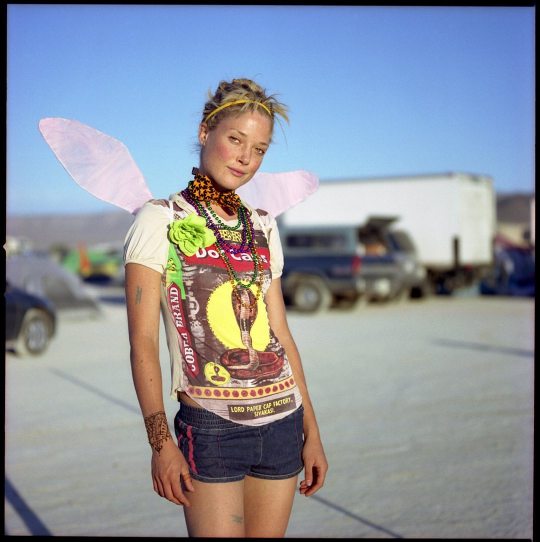
Just as I always carry more than one camera, I generally make more than one photo. When I met Gaia at Burning Man in 2003, she told me she was studying photography at Rochester. Gaia, Burning Man, August 2003 🇺🇦💔🌎💔🌏💔🌍💔🇺🇦 #ThisIsUS #earth #human #family #america #social #documentary #burningman #photographer @burningman #art #festival #people #portrait #photography @hasselblad #hasselblad #camera #mediumformat #fuji @fujifilm_northamerica #film #photography #filmisnotdead #istillshootfilm #pdx #portland #nw #northwest #leftcoast #oregon #streetphotography #ishootfujifilm @hasselbladculture @hasselbladfilmgallery 03080208 and 03080210 Fuji NPS160 Hasselblad 500c/m 120mm Makro-Planar https://www.instagram.com/p/CnQZwEQpgyF/?igshid=NGJjMDIxMWI=
#thisisus#earth#human#family#america#social#documentary#burningman#photographer#art#festival#people#portrait#photography#hasselblad#camera#mediumformat#fuji#film#filmisnotdead#istillshootfilm#pdx#portland#nw#northwest#leftcoast#oregon#streetphotography#ishootfujifilm
36 notes
·
View notes
Text
111 years since the Titanic sank.
There are many stories about the sinking of the Titanic and the people who sailed on her. This my story; originally published in Bygone Kent magazine issue:37 Number 2, over 8 pages.
The Titanic sank on the 15th April 1912. Of the 2,223 onboard, 1517 were lost.
Many were searching for a new life in the United States. One of these was 36-year-old Kate Buss 1873-1972 from Sittingbourne, Kent. She was making the journey alone to marry her Kent-born fiancé, Samuel Willis in San Diego in California. Kate survived and they married three weeks after the disaster.

Picture: Kate Buss before leaving Kent.
Samuel Willis ran a tailor’s shop in Sittingbourne, first in the High Street and then later at 110 East Street. Kate Buss was born at 37 Shakespeare Road, Sittingbourne. In 1901 her father James Buss was listed as a grocer-postmaster at 68 Shortlands Road, Sittingbourne.

Picture: Kate Buss, birth home in Sittingbourne, Kent.
Samuel Willis sailed to America in 1908 and settled in San Diego and then opened his own grocery store. Saving enough, to send money back to Kent to pay for his wife-to-be voyage. Kate sailed on a second-class ticket for E-Deck, number 27849, which cost £13.
At 11.40pm on the 14th April she heard a crash and went on deck. Meeting a friend, she returned to her cabin and put more clothes on, then returned on deck. Along with a female friend they were escorted to lifeboat Number 9. Kate later wrote to a friend, Elsie Sparkes in Halling, Kent: “ I’d just my nightdress, my dressing gown and a long coat. It was terribly cold by the iceberg.”
“ I’ve lost everything to remind me of home, all my photographs, my letters, everything except my rings and watch.”
Lifeboat Number 9 was lowered at 1.30am and it was picked up by the Carpathia at 6.15am. The ship picked up 712 people from 13 lifeboats. The rescue ship arrived at Pier 54 in New York at 9.25pm on the 18th April.

Picture: The lifeboat arriving off the rescue ship; Carpathia.
Staying in the east side of New York at the home of; Reverend William Dalziel 1855-1935 and his wife, Emma 1856-1921, formally of Greenstreet near Faversham. Kate wrote to her mother in Sittingbourne.
“ I do hope you don’t believe most of the newspaper stories. I am well and want you to know this. I have been preserved from reporters, who have been trying to find me.”
She later left New York and started the journey to San Diego, where she was reunited with Samuel Willis. Kate wrote several letters to friends in Halling, near Rochester. “ They had to haul me up the last few steps of the rescue ladder and then someone wrapped me in a rug. I had hot brandy and water in the saloon.”
The memory of the terrifying climb, she said would stay with her for the rest of her life.
Kate married Samuel Willis as planned on Saturday, 11th May 1912.

Picture: Kate Buss and Samuel Willis.
Kate Willis never spoke in public about the tragedy but did so in private, when she became emotional. She successfully avoided the press and didn’t testify to either, to the American or the British boards of inquiry.
In one of the few public statements she made, Kate said: “ I willingly would have waited, if I had known how few lifeboats there were.”
On the 12th July 1972, Kate Buss Willis died in Independence, Oregon. On her gravestone her daughter added a, “ Titanic survivor.”

Picture: Kate Buss Willis in 1950.
Passengers from Kent who died during the Titanic disaster were:
William Thomas Bevan,19 of 95 Richmond Road, Gillingham.
Harry Bristow, 39 of Station Parade, Shortlands, Bromley.
Richard Henry Rouse, 50, of 30 New Road, Sittingbourne.
Thomas Leonard Theobald, 34, 8 Cromer Street, Strood.
Alfred Rush,16, a friend of the Theobald family.
Bernard John Boughton, 25, of 12 Hardinge Road, Ashford.
Percival Thorneycroft, 36 of Bearsted.
Frank Goldsmith, 33 of 22 Hone Street, Strood.
A more complete version was published in Bygone Kent magazine. http://bygonekent.org.uk/
Relations of the Buss and Willis families, helped with details used in this article.
(c) Mike Gunnill 2023.
4 notes
·
View notes
Text
Image descriptions: series of screencaps from Twitter capturing a multiparagraph thread by user DrIbram.
“This #PrideMonth, it is important to recognize non-binary and gender nonconforming people have been here from the beginning of the US. Here is a thread on one of the most influential such persons in early America. An abolitionist minister known as The Public Universal Friend. 1/”
(painted portrait of Public Universal Friend. The Friend is wearing black minister’s robes, a white 18th century neck stock, with a white fringed kerchief also tied around their neck)
“The Friend was a Christian preacher who lived from 1752 to 1819. Assigned female at birth and given the name Jemima Wilkinson, later in life this person eschewed gendered pronouns, preferring to be addressed as ‘the Friend’ 2/”
(black and white bookplate illustrated portrait of The Friend dressed in ministers robes, labeled “Jemima Wilkinson”)
“The Friend was born in to a big White family of Rhode Island Quakers, the eighth of twelve children. In October 1776, they became ill with ‘Columbus fever’, likely typhus. Captured British soldiers on a Navy vessel docked in Providence had brought disease to the area. 3/”
(painting of a Quaker meeting. Inside a large farmhouse room, a crowd dressed in mostly plain black with wide-brimmed hats black is gathered around a woman in the center, who is standing on an overturned washtub to speak)
“On October 11, 1776, the 23-year-old suddenly recovered. They believed they had died, and God had miraculously revived their body and imbued them with a Holy Spirit that was neither male nor female. They began their ministry to ‘a lost and guilty perishing dying world’. 4/”
(photograph of a button featuring a cartoon-style portrait of The Friend)
“For the rest of their life, the Friend refused to conform to the gender norms of the day. Their clothing blended what men and women were expected to wear. They donned the long robe of a minister and the broad hat common for Quaker men, instead of the bonnet women wore. 5/”
(black and white print of a painting of early 19th century men and women sitting in church pews. The men are wearing broad-brimmed hats; the women are wearing plain poke bonnets)
“Although their genderless presentation caused controversy, the Friend amassed female and male followers. This group founded their own sect, the Society of Universal Friends. The Society founded its own town about an hour drive south of Rochester, New York. Named it Jerusalem. 6/”
(photo of outdoor sign reading “Town of Jerusalem Memorial Building: Town Offices)
“Reflective of their roots in the Quaker faith, the Friend espoused a conception of God and humankind that rejected the predestination of the old Puritans. These believers promoted the idea that God had bestowed an “inner light” on all humans regardless of their gender or race. 7/”
(engraved color illustration of a Quaker meeting hall filled with attendants)
“Notably, the Friend was no friend of slavery. They preached against slavery. They denounced enslavement as contrary to God’s principle of all humans as inherently equal Though the vast majority of Universal Friends were White, the sect had Black members. 8/”
(engraved black and white illustration of a cabin, titled “Friend’s Log Meeting House”)
“The Friend urged followers to free enslaved people. In 1782, a follower freed a teenager named Chloe Towerhill in Connecticut. The enslaver had become ‘convinced by the spirit of truth that it is unjust for us to hold any of our fellow creatures in bondage’ 9/”
(scanned page from a book, containing the following text with a highlighted passage: “…love of his dear Son and in obedience to the Holy and Blessed Spirit release, set at liberty, yield up and surrender all our rights, title, claim, or demand that ourselves our heirs, executors or administrators have or can have, of, in and unto a certain Negro Girl named Cloe aged about eighteen years, which according to the laws of man doth belong to us as our own estate, unto her the said Cloe, meaning hereby that she should be a free person in the eye of the laws of the land to all intents, construction and purposes as fully and completely as if she had been free born, or that any white person belonging to this country can have, and for the causes aforesaid to hereby utterly revoke and disannul all pretentions to any right or title to the aforesaid Cloe that we have or any other person or persons have or can have from, by or under us as fully and completely as if she had never been born in bondage to us.” “In witness whereof we, the said Benjamin and Sarah, have hereunto set our hands and seals this twentyeth day of the eleventh month in the year of our Lord 1782.”)
“The Friend ministered until their death in 1819 at the age of 66. As we celebrate this #PrideMonth and every month, let us remember the Public Universal Friend who refused to conform to rigid gender and proslavery norms in the early United States. 10/10”
(painting of the Friend in black minister’s robes, seated in a rocking chair with a halo around their head in the colors yellow, purple, white, and black. Next to them are a cross, an eight-pointed star, and The Seal of The Public Universal Friend: the initials U. and F. with a cross between them and a six-pointed star above)
End image descriptions.



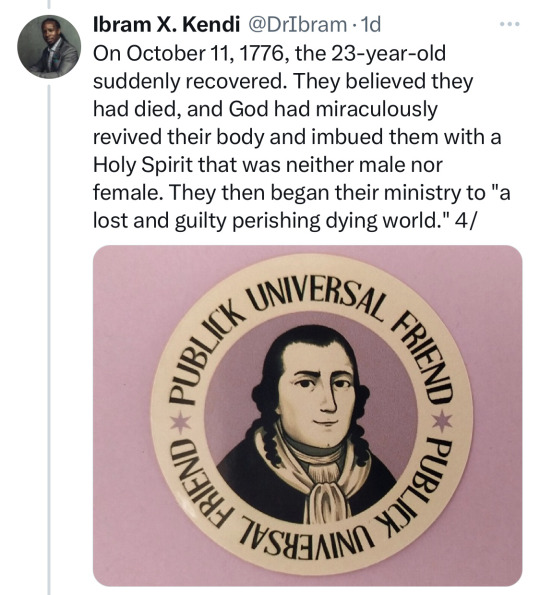
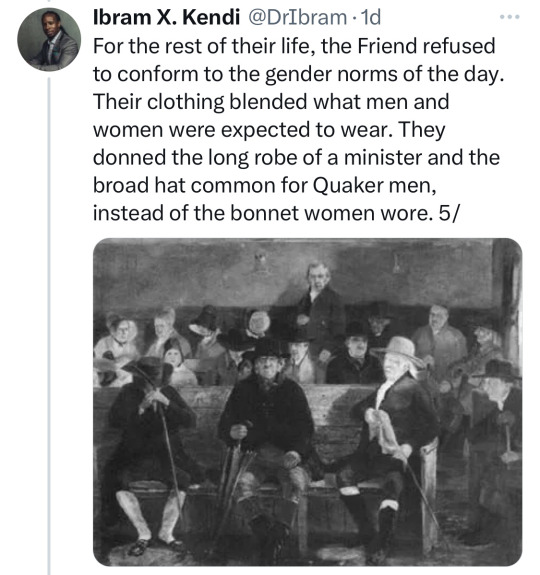


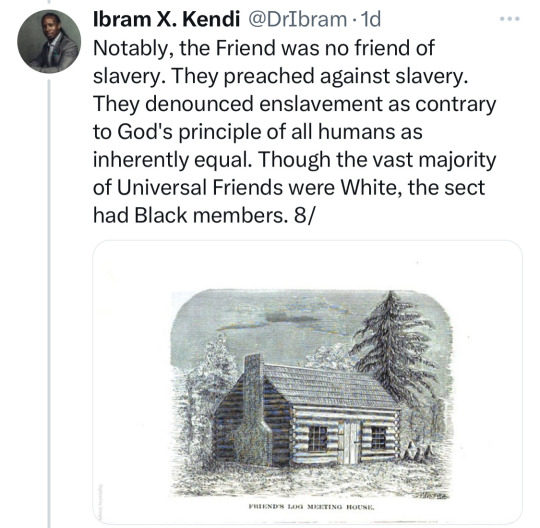

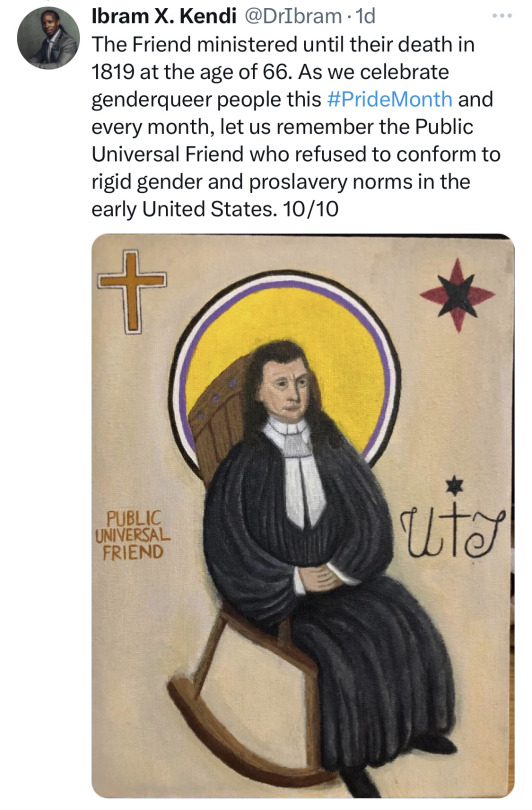
35K notes
·
View notes
Text

Jay-Z has flatly denied allegations that he raped a 13-year-old girl after the 2000 MTV Video Music Awards, describing the accusations as "false" and expressing confidence that the case will soon conclude in his favor. The accuser, known only as "Jane Doe" for anonymity, acknowledged inconsistencies in her account but said that her overall allegations were valid. Speaking to NBC News, she said, "I have made some mistakes," but stood by her allegations. Shawn Carter, also known as Jay-Z, and Sean "Diddy" Combs are named in the lawsuit filed in federal court. The two men denied all charges. Several discrepancies have arisen that question the accusations presented in the story of Jane Doe. i am guilty, CC BY-SA 2.0 https://creativecommons.org/licenses/by-sa/2.0, via Wikimedia Commons One of the inconsistencies is that Jane Doe claimed that her father took her home after the alleged rape, which would have taken more than five hours. Her father, however, cannot recall taking her home. She also pointed out a celebrity whom she claimed to have met at the party, but the celebrity has confirmed that they were not present as they were on tour. Photographic proof accessed by NBC News shows reportedly Combs and Carter outside the location described by Jane Doe. It is yet unclear when the images were shot, or if they went to more after-parties that day. More complicating factors to the story is that Jane Doe claims she was dropped off by a friend in Rochester from New York, to the music hall in New York, that friend has since died. Legal Response and Public Statements The case forms part of the larger lawsuit led by attorney Tony Buzbee in Texas. He represents roughly 120 clients in different complaints against Combs. In response to the new events, Carter and his lawyer, Alex Spiro, have termed the lawsuit as "frivolous." Both addressed the allegations strongly on social media. In a post on X, formerly Twitter, Jay-Z called the lawsuit a "false complaint" motivated by greed and publicity. Today's investigative report proves this 'attorney' Buzbee filed a false complaint against me in pursuit of money and fame. This incident didn't occur and yet he filed it in court and doubled down in the press. True justice is coming. We fight from victory, not for victory. This was over before it began. This 1-800 lawyer doesn't know it yet, but, soon. Alex Spiro further commented on the case saying, "It is staggering that an attorney would file such a serious complaint without proper vetting but would then make things worse by continuing to promote this false story in the press. We are seeking today for the court to dismiss this frivolous case and will address the issue of additional discipline for Mr. Buzbee and all of the attorneys that filed the complaint." Carter has also called for the identity of Jane Doe to be revealed or the case to be dismissed outright. Career and Public Appearances Jay-Z is one of the most successful rappers in history, and he has been in the game for decades. He has won 24 Grammys, and he was one of the first rappers to blow up in the late 1990s and become a global entertainment icon. The allegations surfaced just days before Carter appeared at a high-profile event with his family. Accompanied by his wife Beyoncé and their 12-year-old daughter Blue Ivy, Jay-Z walked the red carpet last week, maintaining a calm demeanor amid the legal controversy. However, as for Sean "Diddy" Combs, who was also embroiled in the lawsuit, he has not come forth with a public statement in particular about the allegations surrounding this specific case. Combs, a veteran of the music and entertainment industries after establishing his "Bad Boy" record label, had a public picture taken with Carter but has denied any wrongs. The inconsistencies in the story of Jane Doe have led to the raising of questions about the credibility of the allegations. Though inconsistencies in an account do not prove its substance wrong, they have been ammunition for Carter and his legal team to argue for the case's dismissal. As the legal process unfolds, both Carter and Combs are firm that they are innocent of the accusations leveled against them. The lawsuit, filed in federal court in New York, has garnered much attention from the media and adds to the broader conversation on high-profile legal cases involving celebrities. Jay-Z's legal team wants this to be dealt with quickly, and both defendants have shown an intention to hold the accuser's legal representation accountable for pursuing what they think are baseless claims. Read the full article
0 notes
Text
Robin Fox Photography, is one of the leading engagement photographers in Rochester NY, specializes in creating timeless memories that reflect your unique love story. With years of experience, Robin Fox Photography has mastered the art of making couples feel at ease in front of the camera, resulting in natural and candid photos.
Robin Fox Photography 250 North Goodman Street #414, Rochester, NY 14607 (585) 330–5984
My Official Website: https://robinfoxphotography.com/ Google Plus Listing: https://www.google.com/maps?cid=17778382636070770175
Our Other Links:
Rochester wedding photography: https://robinfoxphotography.com/wedding-photographer/ family photographers Rochester NY: https://robinfoxphotography.com/family-photographers/
Service We Offer:
Photography wedding photography engagement photography family photography
Follow Us On:
Facebook: https://www.facebook.com/Robinfoxphotography Instagram: https://www.instagram.com/robinfoxphotography/ Pinterest: https://www.pinterest.com/robinfoxphotography/ Twitter: https://twitter.com/RobinFoxPhotog1
#engagement photographers rochester ny#family photographers rochester ny#wedding photographers rochester ny#rochester ny wedding photographer#photographers rochester ny
0 notes
Text
So-Called Spirit Photographs

The Rochester Union is puzzled by the claims of “Spirit Photography.” It says:—“It may not be generally known that for the past two years spirit photographs have been taken in this city, some of them being certainly extraordinary productions. The power granted by the inhabitants of the unseen world to reproduce their features on a camera is not given to every one, and in this section, so far, Miss Hedley, who runs a photograph gallery on State-street, has a monopoly of what is likely to turn out a most lucrative business. Hearing of Miss Hedley's gift in this line, a citizen, being of a curious turn of mind, determined to see what there was of it. Visiting the gallery, he told the proprietress that he understood she took spirit photographs, and he wished to test her skill. ‘I am not certain I can succeed,' was Miss Hedley's response ; ‘but we can try.’ ‘Would you allow me to pass my handkerchief over the glass before you prepare it for the camera?' 'Oh, certainly, as many times as you wish.’ The visitor carefully rubbed the glass on both sides, after which he stood while the collodion was put on, and when the glass was put in the camera he took his seat. The cap of the instrument was removed, and in a few minutes the picture was taken. On the negative being taken out and held up to the light, some faint forms were visible. ‘What are those marks on the glass?’ asked the citizen. ‘Those are faces of some persons you will no doubt recognise when printed plain.’ ‘Well, when can I obtain a proof of the picture?’ ‘Oh, by to-morrow.’ ‘No; I intend to have a proof while I wait, as I do not intend there shall be any humbug in this matter.' After waiting about two hours the proof was taken, toned, and placed on a card. It was then that he recognised in the most distinct manner the faces of his sister and child, who had died some time previous. Not wishing to be made the victim of an optical delusion, he put the card in his pocket, and on going home, showed it to his wife, without saying a word. She immediately recognised the faces on the print, and her husband then told her how it was taken. It was shown to friends of the family, who recognised them. —Photographic News. (Harbinger of Light, 01.03.1880)
0 notes
Text

CHARACTER INFORMATION
face claim: Alexandra Daddario
full name: Ashley Rose Newman
nickname(s) / goes by: Ash (hates being called Ashley)
pronouns & gender: cis woman, she/her/hers
sexuality: lesbian
birth date: August 9th, 1989
birth place: Merrock, ME
arrival to merrock: local
housing: Coast and Pier
occupation: American Sign Language interpreter, employee at Universal Rocks
work place: Universal Rocks
family: Kellan, Cage, Elliot, Lucie, and Clementine Newman
relationship status: Complicated; going through a divorce right now
PERSONALITY
As one of the middle Newman children, Ash struggled to stand out and feel like her own person. But she is also so grateful to have a large group of siblings that have her back no matter what. She is very loyal to them, and perceptive of their feelings. She is also hardworking and focused on her goals, but she can be stubborn to the point of getting in her own way.
WRITTEN BY: Elle (she/her), est.
BACKGROUND / BIO
triggering / sensitive content: parental death x2
Born in 1989 - after the boys, but before the other girls - Ash's earliest memories are of trying to keep up with her older brothers, and of being surrounded by love. Her mother died when she was in kindergarten, a dark stain on an otherwise happy childhood. Ash was so young when it happened, that she doesn't have many memories of her mom. When she thinks of her mom, the first image that pops in her mind is of the photograph she had on her dresser until she was eighteen. In some ways, it was easier to not remember her well enough to miss her. But other times, she felt angry that she didn't have the time to bond with her mom.
Even though it felt for a time like the Newman world had stopped turning, the rest of the world didn't get the memo. Not long after the funeral, a new boy transferred into her class. After some drama about cooties, the two were inseparable. By second grade they were 'dating'. At the age of seven, that didn't really mean much, but they were acting more like a stereotypical couple by middle school. By their senior year of high school, many people felt the need to tell them how most high school relationships didn't last. That, with Ash going off to college and her boyfriend staying back, they wouldn't last a semester. But she had known since second grade that they were going to get married and have 2-3 kids. She was so sure of this future, and wanted to shut all the doubters up, so she proposed to her boyfriend and they were married a week before she left for college. Without much time to plan, the wedding was only immediate family and an ordained minister. Her white dress came from the Prom clearance sales at the mall, and the closest thing they had to a reception was going out to dinner with the Newman family that night. It was far from Ash's dream wedding, but they had agreed to a proper wedding once Ash had graduated from college and both had stable careers.
For four years, they were long distance while Ash attended Rochester Institute of Technology. Growing up with a Deaf brother who was only one year older than her, the family had still been learning sign language when she was born. It became her first language, as she picked it up much faster than the English that was spoken around her at the time. Before her first verbal word, she had already learned a few signs. And she had grown up keeping an eye out for her older brother, always ready to throw hands with anyone who had a mean comment about him (although she never actually got in a fight, and almost definitely would have lost if she did). Although she didn't have classes with her brother until high school, she was always in awe of his sign language interpreter whenever she got to see them in action, and knew fairly young that she wanted to become an interpreter herself.
After graduating, Ash made the decision to stay in Rochester. She had the connections to immediately dive into a career in interpreting. As a freelance worker, there were a lot more opportunities for work and income in a large city than there were in her hometown. Her husband supported her decision and moved to New York. Now that they were living together, things didn't feel as easy. Ash had always known that she liked girls, and had come out as bi several years earlier. But the truth was, she had never felt that same kind of connection with her husband. But they were married, and the plan had always been to raise kids with him. He was her best friend, and that was more than most people ever got in their marriage. So while she felt no shame about liking women, she was determined to force herself to learn to feel the same way about her husband. She couldn't be a lesbian, because that would ruin the plan she'd clung to for seventeen years. Soon followed so many failed attempts at starting their own family. So many crushed dreams, and so much time spent realizing how much she disliked being intimate with her husband. After seven years of marriage, Ash finally broke down and admitted to both of them that she didn't like men.
The divorce was hard and emotional, but it was made easier by the lack of any bad blood between the two of them. Now single for the first time in her life, Ash had no idea what to do with herself. She had a few one night stands with women and they felt amazing, but she wanted more. It was through a dating app that she met a woman who lived in California, and only three months later Ash was moving across the country to be together. Six months after that, they were married. The wedding was beautiful, with a honeymoon in Europe and five happy years of marriage.
And then Ash got the call. Her father had been sick for awhile, but he was getting worse. It had been twelve years since Ash called Merrock home and while she wasn't in the right stage of her life to move back, she had the privilege of taking some time off work to come back and spend a couple months with her family before Jason passed away.
Ash thought she'd be prepared to lose her dad - at least, as prepared as anyone could be. But this time the grief was so much more real. Her mom's death had always felt more abstract to her, missing the idea of a maternal figure more than an actual person. But she was older now and had a lot more memories with her dad, and an adult understanding of what losing him meant. She knew she had her siblings, but they were on the other side of the country and the idea that she was now an orphan terrified her. Her wife couldn't do much to comfort her, and emotionally she could feel herself shutting down and going through her life like a zombie. By the time she snapped out of it, her marriage was in ruins and they were sleeping in different bedrooms. Ash suggested counseling - both for herself and as a couple - but her wife refused to take the sessions seriously. After going on a work trip for a week, Ash came home to find her wife had moved out while she was gone.
The month that followed was messy. The two started the divorce process, but her wife was determined to drag it out as long as possible. No sooner did they announce they were splitting up than Ash moved back to Merrock to be with her siblings.
1 note
·
View note
Text
Artist Research Entry 4: Kristy Carpenter

Kristy Carpenter most likely has one of the most impressive backgrounds I've seen so far. Graduating from Harvard with a BA in Visual and Environmental Studies and earing her MFA in Photography at the Rochester Institute of Technology, this woman certainly has the education to back up her skills in photography. This photographer has showcased her diverse artistic approach through both solo and group projects over the years. But despite that, he most frequent works center around her home and family life, or at least subjects that relate to them. One such project that does that is Since We've Spoken. This project covers the death of her father and what comes with familial transitions. From the images alone, there is a great sense of sorrow and loss can be felt as well as themes of change and how it affects families like hers.

I found a strange sense of relatability from this artist. Despite her incredible education and skills, she still maintains that small town feeling about herself through her work and their themes. Something that I hope to keep with my future projects.
Links:
Kristy Carpenter - LENSCRATCH
Since we've spoken — Kristy Carpenter
0 notes
Text

Lois Gibbs never avoided the spotlight in her fight to protect Love Canal's families from chemical waste. The press surrounds her outside the Love Canal Homeowners Association in 1980 as Gibbs waits for a phone call from the White House. Photograph By Mickey H. Osterreicher
Meet The Mom Who Took On Toxic Waste—And Won
The Love Canal disaster transformed homemaker Lois Gibbs into an environmental warrior after she learned her Niagara Falls neighborhood was built on poisoned ground.
— By Erin Blakemore | April 19, 2024
When Lois and Harry Gibbs moved to a three-bedroom home in Niagara Falls, New York, in 1972, the young wife thought she’d hit the jackpot. “I really thought I had succeeded in finding the best house in this entire country,” Gibbs recalls. Her husband, a chemical worker, had a good job. Her neighbors were close-knit, the area idyllic. And kids, were everywhere, roaming the neighborhood, swimming in the local creek—the Love Canal neighborhood was an area “alive” with children.
But things were not what they seemed. Under the surface, in the soil beneath its perfect houses, lay chemical contamination from a toxic waste dump—a ticking time bomb that would result in disease, tragedy, and Gibbs’ transformation from shy housewife into a nationally known environmental activist.
Buried Dangers
Years earlier, the partially developed Love Canal became a dump, courtesy of the Hooker Chemical and Plastics Corporation, which buried over 20,000 tons of toxic chemicals there between 1942 and 1952. Eventually, the company leased the area to the Niagara Falls Board of Education for $1, complete with a deed that contained a disclaimer excusing Hooker Chemical from any liability related to the chemical dumping. In the years that followed, the land surrounding 16-acre landfill became a neighborhood complete with tract homes, churches, and trees.


Left: Founded in 1903 in Rochester, New York, the Hooker Chemical and Plastics Corporation disposed of some 20,000 tons of toxic waste at Love Canal between 1942 and 1952. Photograph By Bettmann/Getty Images Right: Map
By 1978, the site was home to an elementary school, and houses like Gibbs’ lined Love Canal’s placid streets. The school was a hub for the area’s stay-at-home moms, Gibbs recalls. Since the school didn’t have a cafeteria, Gibbs and other women would bring their children their lunches at mid-day. She’d walk to the 99th Street School, pushing her daughter in a stroller, and spread out a blanket on the school playground, where the family would eat along with the other mothers and kids.
“Oh, my God,” she says. “How many times did we eat on a toxic waste dump?”
Surfacing troubles
The first sign of trouble at Love Canal appeared in 1976, when the Niagara Gazette reported that some homes were experiencing chemical leaching in their basements. But Gibbs didn’t take note until her five-year-old son Michael began having seizures. “My sense was that the playground was where he was getting exposed,” she says. “I really thought that Michael was somehow more sensitive, and that the school board should move him [to another school] right away.”
The family had no history of epilepsy, and a consultation with her brother-in-law, a biologist, made her wonder if Michael’s problems had something to do with the chemicals. Citing the potential danger of the site, she petitioned the school board to move Michael. But when they denied the request, she sprang into action.
“I have an Irish temper. You can’t sit there and tell me you’re not going to move my child,” she says, her voice still bristling forty-six years later. “We’re gonna fix this.”
Taking Action
Soon, she was going door to door with a petition to shut down the school. But as she surveyed her neighbors, she realized she wasn’t the only mom whose kid was sick.
Health problems were everywhere in Love Canal, from hyperactivity to epilepsy, migraines to miscarriages. Neighbors began telling her about cancer, kidney problems, lung issues. Eventually, Gibbs realized that a full 56 percent of children born to Love Canal residents within the last five years had been born with a congenital anomaly.
“I heard about a 12-year-old who had to have a hysterectomy,” says Gibbs. “A woman with two crib deaths. These weren’t normal things.”
Though the state health department agreed to run tests on homes near the dump site, progress was slow. Once officials began environmental testing, residents were shocked by the sheer extent of the contamination. It wasn’t just the playground. It was the basements. The back yards. The bedrooms. The drains. An ocean of deadly chemicals was percolating upwards from the ground: benzene, dioxin, toluene. Ultimately, over 100 deadly compounds were confirmed at the site. The air was polluted; so was the groundwater.
Poisonous Impacts
By then, Gibbs was president of the Love Canal Neighborhood Association, a grassroots group devoted to figuring out what was wrong in their neighborhood. Obtaining evidence of the unfolding disaster turned out to be the easy part. Getting the right people to listen was another matter entirely, says Gibbs.
The women put in hundreds of hours on the telephone, going house to house, begging local and then national officials to help. They circulated petitions, collected evidence, and lobbied. Once shy and reserved, Gibbs was now in the center of a tornado of publicity, unanswered pleas, and a continual sense of dread about what the chemicals were doing to her community.
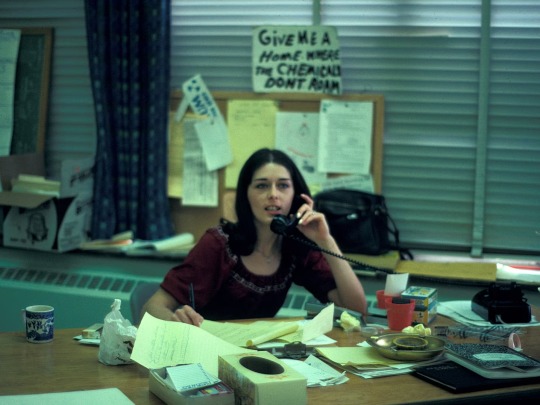
Lois Gibbs's grassroots efforts brought national attention to the Love Canal environmental disaster. Photograph Courtesy of University Archives, University at Buffalo 🦬, The State University of New York
Meanwhile, the life she loved was collapsing before her eyes. People had started dying, including a young boy, John Allen Kenny, who had often swum in the creek behind his house. Gibbs found herself advising and comforting her distraught neighbors, including one chemical worker who unburdened himself to her.
“I had never seen a man cry before,” she recalls. “This was a macho, blue-collar man. He talked about playing football with the little boy.” These kinds of incidents became a daily occurrence.
So did the pressure. “No longer is her house clean, her floors waxed, and her dinner on the table by five o’clock,” a reporter wrote in 1978. This was a bone of contention with her husband Harry, who expected her to cook him dinner. “When is this going to be over?” he’d ask. “I want dinner.”
Fighting While Female
Gibbs’ identity as a stay-at-home mother turned out to be a blessing and a curse. As one reporter wrote, it enabled her to ask “innocent but deadly” questions, disarming powerful officials without intimidating them. But it also opened her up to criticism, gossip, and sexism.
“I’m a woman, so I can’t be too bright,” says Gibbs. People would ask if it was her “time of month,” implying that her pleas were hysterical. Eventually, she says, she heard that lawmakers in Albany had given her a nickname. “Instead of calling me the Love Canal president, it was ‘The Bitch.’”
In August 1978, state officials evacuated pregnant women and children under the age of two from the Love Canal neighborhood. But that wasn’t enough for Gibbs and her neighbors. They filed lawsuits, picketed, and disseminated the growing evidence that the neighborhood was even more polluted than first thought. Finally, in May 1980, President Jimmy Carter declared a national emergency at the site. Ultimately, about 950 families left Love Canal.
The health consequences of Love Canal were dire. Follow-up studies showed that women living in the neighborhood during their reproductive years were twice as likely to give birth to a child with a congenital anomaly and at higher risk for giving birth to a baby with low birth weight. Residence in the neighborhood has also been linked to higher rates of rheumatic heart disease, heart attacks, and cancer of the lungs, kidney, and bladder. However, the exact effects of the environmental disaster may never be fully ascertained, given the difficulty of determining precise exposure rates to chemicals in the landfill.
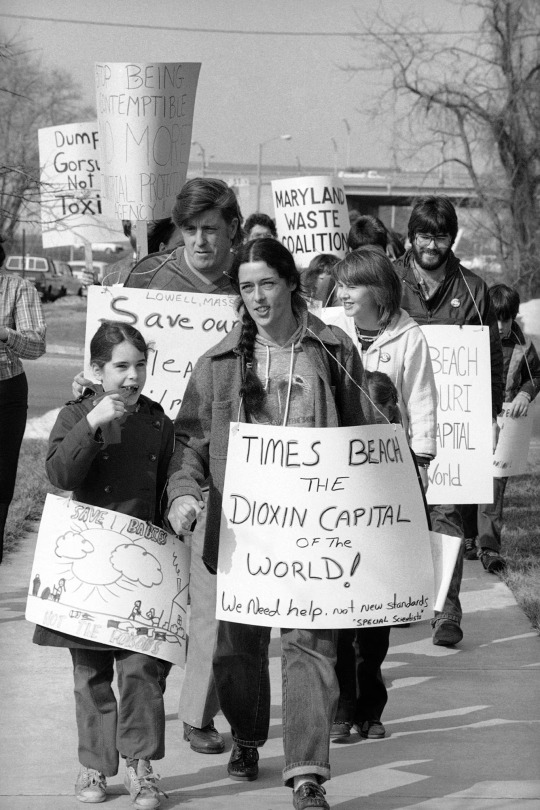
Gibbs continued to fight for environmental justice even after Love Canal. Here she leads a protest outside the Virginia home of EPA official Rita Lavelle, who would be convicted in 1984 of misusing funds from the Superfund program. Photograph By Scott Stewart/AP
Love Canal Legacy
Today, Gibbs is considered one of the mothers of the environmental movement. Her efforts at Love Canal put the dangers of toxic chemical contamination into the national spotlight, prompting the creation of the Environmental Protection Agency’s Superfund program, a program that cleans up contaminated sites, and the attention of scientists who continue to study the dangers of chemical contamination for humans.
Her story—and that of the others who fought for environmental justice in the Love Canal neighborhood—has inspired many TV films and documentaries. The latest is American Experience’s Poisoned Ground: The Tragedy at Love Canal, premiering on Earth Day 2024.
Their tale is closely tied to neighborly collaboration, but ironically, Gibbs’ fight led to the demise of the neighborhood she loved so much. Though she’s still in contact with her former neighbors, the Love Canal evacuation spread them all over the country. Eventually the entire Love Canal neighborhood was demolished. “It’s gone. It’s just gone,” says Gibbs. “It’s hard to put a value on that.”
Though her children are currently healthy, she says she still worries for their long-term health and that of their successors. “There’s always a cloud,” says Gibbs. Ultimately, though, she sees her work at Love Canal as a triumph. “We won,” she says. Gibbs went on to found the Center for Health, Environment, and Justice, becoming a key figure in the environmental movement and inspiring generations of grassroots activists.
And if she could do it, anyone can.
“Democracy works,” she says. “[We] stood together and had a united goal. You can do that for any issue. If people would participate in democracy, we could change the world in ways that are not even imaginable right now.”
#Toxic Waste#Activism#Environmental Concerns#Environmental Justice#Modern History#Pollution#Environment & Conservation
1 note
·
View note
Text
Documenting local history as it happened
By Jonathan Monfiletto
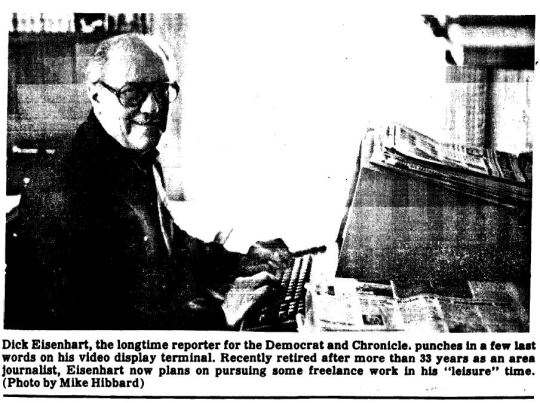
Although I had seen the box before, or at least the name of it on a list of archive boxes, it was while searching for photos of St. Mark’s Terrace that I first encountered and browsed our Dick Eisenhart collection of photos. And I found not only photos of St. Mark’s Terrace – both during and after its construction on the corner of Chapel and Liberty streets more than 50 years ago – but also photos of the fire that destroyed the Penn Yan fire station on Main Street in 1967 and photos of the dedication of the current Elm Street firehouse the following year. There were photos of well-known people, such as Finger Lakes resident and former New York State Lt. Gov. Mary Anne Krupsak, and photos of ordinary people who are, often and unfortunately, unidentified in the collection.
Looking through our subject files that contain clippings of newspaper stories, I see Dick Eisenhart’s byline on articles quite frequently, as often what I am researching now is what he was reporting on then. He covered the news of Penn Yan and Yates County for the Democrat & Chronicle and the Times-Union, the morning and evening newspapers, respectively, in Rochester. For more than three decades, from 1952 to 1986, Eisenhart served as both reporter and photographer as he worked out of his Keuka Street home office, capturing the events and happenings of the Penn Yan area and thus documenting our local history as it happened. Though I neither met Eisenhart during his lifetime (he died in January 2018) nor was alive during his newspaper career (I was born two years after he retired), I feel a kindred spirit with him – from one who documented local history as it happened to one who interprets that local history to this day.
Now, if you follow our Facebook and Instagram pages (“Yates County History Center” and “yates_county_history_center,” respectively), you will soon see we are sharing some photos from our Eisenhart collection – photos he took himself in the course of his work as a news reporter and photographer – in order to display but also identify the people in these photos. As we begin sharing these photos and seeing your comments and memories about Eisenhart’s life and work, I wanted to once again dive into our subject files – this time to find out more about the man behind the stories and the photos.
And in doing so, I was treated to a walk down memory lane with Eisenhart himself; prominently located in the Eisenhart family file is an April 2000 article in the Finger Lakes Times discussing Eisenhart’s donation to the Yates County History Center of his personal collection of his photos while telling the story of his lengthy and distinguished news career. Of course, the article begins with the infamous Penn Yan Fire Department fire and Eisenhart’s eyewitness account of the blaze – including his paying a stranger to deliver his rolls of film to the Democrat & Chronicle office for the newspaper to publish. While a prominent example indeed, the fire is just one example – as even the Times article attests – of the many moments Eisenhart covered and captured during his career. From fires, accidents, and court trials to county, village, town, and school board meetings and anything and everything in between, Eisenhart was there to document it for more than 30 years.
With credentials like that, one might believe Eisenhart to be a candidate for Mr. Penn Yan or Mr. Yates County, if ever there were such a contest or competition. However, he actually did not grow up in Penn Yan or Yates County; according to his obituary, he was born in Horseheads and grew up in Watkins Glen. After graduating from Watkins Glen High School, he served in the Philippines and Japan during World War II – a service that included an encounter with one of the women accused of being Tokyo Rose, the Allied term for a group of female Japanese radio broadcasters who targeted Allied troops with propaganda messages. Eisenhart even testified for the prosecution when this woman – Iva Toguri D’Aquino, whom Eisenhart had met during his stint as a guard at a Japanese prison where she was an inmate – was convicted and then imprisoned for treason against the U.S. government.
Coming home from his service, Eisenhart graduated from Rochester Business Institute and then followed his childhood dream of becoming a news reporter. He married his wife, Sylvia, and they settled in Penn Yan with their three children, Susan, Steve, and Donald. That news career spanned from exclusive interviews with Bobby Kennedy and Martin Luther King Jr. to local residents on the street exclaiming, “Hey, Mr. Eisenhart, take my picture!”
The Times article refers to Eisenhart as “one of the last old-time newsmen who felt strongly that news should be covered in person, rather than by phone,” meaning Eisenhart appeared in person to the events he covered instead of interviewing people about it afterward. Old-time is indeed an apt description; he covered his beat in the days before the prevalence of computers and the internet. He tapped out his stories to meet the evening deadline first on his L.C. Smith typewriter and then on a teletype machine that transmitted his stories to the Rochester newsroom. He even processed his own film and printed his own glossy black-and-white photos in a darkroom adjoining his home office. This entailed his rushing the prints to Penn Yan’s downtown bus stop by late afternoon so a Greyhound bus could transport them to Rochester, where a courier waited to pick them up and deliver them to the newspaper.
Despite meeting King following his 1963 baccalaureate address at Keuka College and Kennedy during his 1964 U.S. Senate campaign, Eisenhart told the Times it was the ordinary, everyday people – probably many of the people depicted in the photos in his collection – whom he enjoyed meeting the most: “I met so many people and built so many great friendships. The people are what make the job, and the fact that you are learning something new every day.”
It is these people – Eisenhart’s friends and fellow Penn Yan and Yates County residents – whom you will find in the photos we are sharing. We hope you enjoy seeing these photos, and if you know something about – or someone in – any of the photos, please let us know.
0 notes
Text
Mrs K.
One afternoon Mrs K gave me a heavy, thick photograph album. She said she wanted me to have it. I could see that she didn’t want to explain anything so I simply thanked her and waited until I got home before examining it.
There weren’t any photographs, instead the cellophane windows contained addressed envelopes, all ‘airmail’, all with stamps; hundreds of them. All were addressed, in various handwritings to Mrs K and her husband by people in the US. She had preserved the envelopes, not the contents. The first had a stamping in 1946 the last is 1981.
They came from several people in Chicago, Denver, Houston Tex., Skokie Ill., Miami Beach, Melrose Park, Rochester, Canton Ohio and others that are indecipherable - plus some from ‘US Army PCIRO’ and ‘Air Force Postal Service’.
It’s my theory that these people had managed to survive the Holocaust, perhaps family members, perhaps friends.
Mrs. K. herself had got out of southern Germany in the mid/late 1930s. She worked as a servant to a family in Holland Park, London and then, again as a servant in Manchester. Some of her family made the mistake of believing that the safest place was Berlin, to be in the relative calm at the centre of the storm; Mrs K learned of their fate but did not talk about it.
She married a fellow survivor, a very gentle man and they had a daughter, a shy girl who was brought up to never tell anyone of her Jewish heritage. In her seventies Mrs K, now a widow, was approached by a history student who wanted to use her for a PhD thesis. They met several times and I think it was burdensome for her. Later I was given a copy - about 200 pages and a lot of photographs. It was bleak reading; not just the misery of seeing her early life shattered by persecution, but the emptiness of an affluent but disturbed existence in England. They lived in comfort, had expensive holidays - top NY hotels, long stays in Miami etc but the perpetual sadness, masked by irritation, never eased up.
Except the way her face lit up when she met me and Pat - the effortlessness of our friendship - the joy at our tiny gifts - her delight in choosing cakes and getting the tea ‘just right’.
Dear Mrs K. xx
0 notes